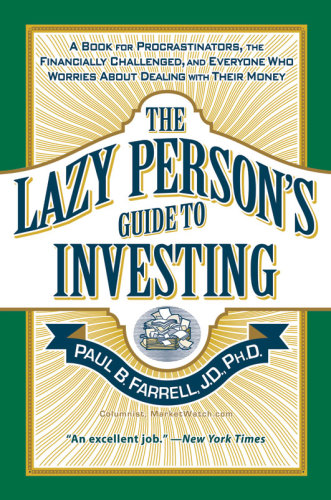
The Lazy Person's Guide to Investing
A Book for Procrastinators, the Financially Challenged, and Everyone Who Worries About Dealing with Their Money
کتاب های مرتبط
- اطلاعات
- نقد و بررسی
- دیدگاه کاربران
نقد و بررسی

December 15, 2003
Popular CBS Marketwatch
columnist Farrell provides a thoroughly enjoyable and straightforward look at what he sees as "the future of investing"—"simple lazy portfolios that'll work for anyone and are easy to understand." He provides three different model portfolios based on one simple formula: "rock-solid, easy-to-understand asset allocation using no-load index funds." Farrell is a huge proponent of no-load funds such as the Vanguard 500 Index, which tracks the Standard & Poor 500 listing of America's largest companies, and the Vanguard Total Bond Market Fund Index, which matches the performance of the Lehman Brothers Aggregate Bond Index. Farrell persuasively argues that the strong long-term performance of these funds, even during hard market times—along with the strong performance of other Vanguard index funds such as those for large-cap and small-cap value—proves that "the only rational strategy" for the vast majority of America's 94 million mutual fund investors is "a simple buy 'n' hold strategy" that diversifies portfolio assets across multiple categories of assets. Packed with clear examples of how regular people can easily handle their own investments, Farrell's guide also takes on other sacred cows, such as Wall Street's belief that brokers know more than you do, and provides an exciting and illuminating section on no-load stocks, or DRIPs, which he calls "Wall Street's best-kept secret."

September 4, 2006
This power-to-the-people personal finance book is heavy on motivation: investing is not rocket science; anyone can get started with as little as $25 a month; various financial products eliminate the middle man and charge waifishly thin expenses (which, as Farrell notes, is the only sure-fire way to get a great return). Summers brings great enthusiasm to Farrell's populist manifesto, whether he is praising Vanguard to the skies (does Vanguard get a kickback for this gushing and relentless product endorsement?) or urging people to set up foolproof automatic investments from their paychecks or checking accounts. At times, the marriage of Summers's syrupy voice and some of Farrell's cheesier examples—such as a monkey that allegedly got better returns than Wall Street gurus merely by choosing investments at random—can err on the juvenile side. Also, the gimmicky names of Farrell's various portfolios, such as the Couch Potato and the No-Brainer, begin to run together in the audio version. Still, there is solid advice, and Summers is a competent and sometimes charming narrator. Simultaneous release with the Warner paperback (Reviews, Dec. 15, 2003).

January 1, 2004
Do we really need another investment book? Farrell, a columnist with CBS Marketwatch and the author of several investment books, seems to think so. There is nothing in this book that hasn't been covered elsewhere, but Farrell presents his advice in a clear and straightforward manner. The "lazy" person is someone who wants an easy portfolio to maintain. The author focuses his information on mutual funds and describes several portfolios that contain two to ten funds for the investor. He is a fan of index funds and throughout the book offers the usual advice of buying and holding, purchasing no-load funds, and contributing to funds through automatic investment plans. He assures the reader that managing a portfolio does not take a lot of time or skill. For those who do want to manage their investments more aggressively, the author presents advice on how to trade with only ten percent of one's total investment. There is a bibliography of other investment sources, but a glossary of terms would have been useful. An optional purchase for public libraries.-Stacey Marien, American Univ., Washington, DC
Copyright 2003 Reed Business Information.

























دیدگاه کاربران